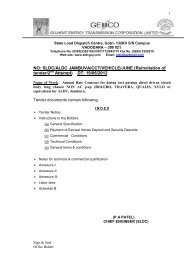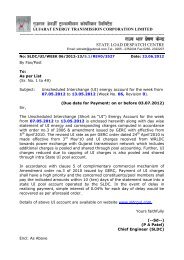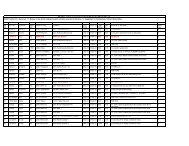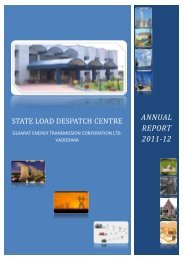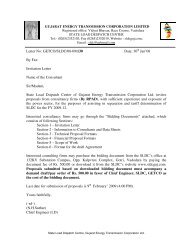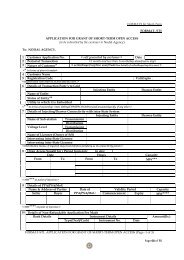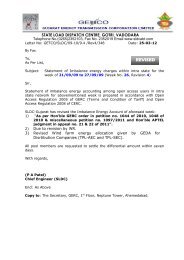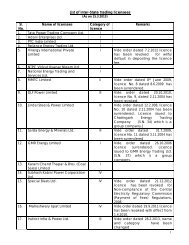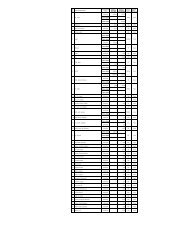Intra-State ABT order - State Load Despatch Centre (SLDC)
Intra-State ABT order - State Load Despatch Centre (SLDC)
Intra-State ABT order - State Load Despatch Centre (SLDC)
Create successful ePaper yourself
Turn your PDF publications into a flip-book with our unique Google optimized e-Paper software.
BEFORE THE GUJARAT ELECTRICITY REGULATORY COMMISSION<br />
AHMEDABAD<br />
Shri G. Subba Rao, Chairman<br />
Shri K.P. Gupta, Member<br />
Shri Man Mohan, Member<br />
Order No. 3 of 2006<br />
Order<br />
Date: 11 th August, 2006<br />
In the matter of:<br />
“Bringing Generating Stations of Gujarat <strong>State</strong>, Distribution<br />
Licensees and other persons under the purview of <strong>Intra</strong>-<strong>State</strong><br />
Availability Based Tariff (<strong>Intra</strong>-<strong>State</strong> <strong>ABT</strong>)”<br />
1. The Central Electricity Regulatory Commission (CERC) by its <strong>order</strong><br />
dtd. 4.1.2000, introduced the scheme of Inter <strong>State</strong> <strong>ABT</strong> in<br />
Western Region w.e.f 1 st July, 2002. The main features of the<br />
scheme in relation to tariff are:<br />
a. Capacity Charge linked to Availability;<br />
b. Energy Charge linked to Scheduled Generation;<br />
c. Unscheduled Interchange (UI) Charge linked to the grid<br />
frequency.<br />
2. The implementation of Inter-state <strong>ABT</strong> has brought about the<br />
following improvements in the operation of the regional grid as<br />
indicated in the FOIR sub-committee report:<br />
Page No. 1 of 23
a. Grid frequency has dramatically improved from 48 – 52 Hz<br />
range to 49.0 – 50.5 Hz range for most of the time.<br />
b. A higher consumer demand is being met, due to built-in<br />
incentives to maximize generation in peak-load hours.<br />
c. Generating stations are being operated according to real<br />
merit <strong>order</strong>, on region-wide basis, through decentralized<br />
scheduling.<br />
d. Hydro-electric generation is being harnessed more optimally<br />
than before.<br />
e. <strong>State</strong>s’ shares in central generating stations have acquired<br />
new meaning and grid discipline is encouraged.<br />
f. Open access, wheeling of captive generation and power<br />
trading have become possible through the UI mechanism for<br />
handling deviations/ mismatches.<br />
g. <strong>State</strong>s meet their occasional excess demand by over drawing<br />
from the regional grid and paying applicable UI charges to<br />
the under-drawing states.<br />
3. The National Electricity Policy issued on 12 th February, 2005 also<br />
accepts the benefits of <strong>ABT</strong> introduction at the national level and<br />
has advised the SERCs to introduce <strong>ABT</strong> at the <strong>State</strong> level within<br />
one year. The relevant portion of para 5.7.1 (b) of National<br />
Electricity Policy reads as follows:<br />
“The <strong>ABT</strong> regime introduced by CERC at the national<br />
level has had a positive impact. It has also enabled a<br />
credible settlement mechanism for intra-day power<br />
transfers from licenses with surpluses to licenses<br />
experiencing deficits. SERCs are advised to introduce<br />
the <strong>ABT</strong> regime at the <strong>State</strong> level within one year.”<br />
Page No. 2 of 23
4. The GERC (Terms and Conditions of Tariff) Regulations, 2005<br />
(GERC Tariff Regulations) notified on 31 st March 2005 specify that<br />
the Commission will issue detailed <strong>order</strong>s for operationalisation of<br />
<strong>ABT</strong> after consulting the stakeholders and considering their degree<br />
of preparedness for its implementation. Further, the Gujarat<br />
Electricity Regulatory Commission (Open Access in <strong>Intra</strong>-state<br />
Transmission and Distribution) Regulations, 2005 provide for<br />
implementation of the <strong>Intra</strong>-<strong>State</strong> <strong>ABT</strong> System for operationalising<br />
Open Access.<br />
5. The reorganization of the erstwhile Gujarat Electricity Board (GEB)<br />
has resulted in creation of seven independent entities (one<br />
generating company, one transmission licensee and four<br />
distribution licensees and one holding/trading company). More<br />
over, two private distribution licensees and state controlled as well<br />
as private generating companies are also functioning in the <strong>State</strong>.<br />
In addition, new generating companies are likely to come up in the<br />
near future. Under the <strong>State</strong> Captive Power Policy-1998 some of<br />
the owners of CPPs are supplying power to their group companies<br />
using the state grid. Further, under the Wind Power Policy-1993<br />
and 2002 of the Government of Gujarat some of the owners of wind<br />
farm are supplying power to grid and some are wheeling power to<br />
their manufacturing units for their own use. Moreover, the<br />
Regulations notified by the Commission for Open Access and<br />
Power Purchase from Renewable Sources will also increase the<br />
number of players using the <strong>State</strong> Grid.<br />
6. The Indian Electricity Grid Code (IEGC) also provides that the<br />
operation of all entities within the <strong>State</strong> would be coordinated by<br />
the concerned <strong>State</strong> <strong>Load</strong> <strong>Despatch</strong> <strong>Centre</strong> (<strong>SLDC</strong>), who in turn<br />
would coordinate with Regional <strong>Load</strong> <strong>Despatch</strong> <strong>Centre</strong> (RLDC) on<br />
Page No. 3 of 23
eal time basis. In the existing Interstate <strong>ABT</strong>, Gujarat participates<br />
as a single unit connected to the Western grid and also gains or<br />
loses in case of deviations from schedule. This may be due to<br />
deviation from schedule by individual entities in the <strong>State</strong> and<br />
therefore, such deviating entities have to bear the consequences.<br />
The increase in users of the <strong>State</strong> Transmission network calls for<br />
efficient energy accounting and balancing mechanisms. Hence,<br />
Inter <strong>State</strong> <strong>ABT</strong> principles have to be replicated at the intra-state<br />
level. In view of the above, the Commission hereby resolves to<br />
implement the scheme of <strong>Intra</strong> <strong>State</strong> Availability Based Tariff<br />
(<strong>Intra</strong>-<strong>State</strong> <strong>ABT</strong>).<br />
7. The tariff under the <strong>ABT</strong> regime will have three components<br />
namely the capacity charge, the energy charge and the Unscheduled<br />
Inter-change charge (UI Charge).<br />
a. Capacity Charge:<br />
Capacity Charge will be related to ‘Availability’ of the<br />
generating station.<br />
As defined in sub clause (v) of Clause 13 of GERC Tariff<br />
Regulations, 'Availability' in relation to a thermal generating<br />
station for any period means the average of the daily average<br />
declared capacities (DCs) for all the days during that period<br />
expressed as a percentage of the installed capacity of the<br />
generating station minus normative auxiliary consumption<br />
in MW.<br />
Computation and payment of Capacity Charge at various<br />
‘Availability’ levels shall be regulated according to provisions<br />
made in Clauses 20, 29 and 47 of GERC Tariff Regulations.<br />
Page No. 4 of 23
However, for the PPAs entered into by the erstwhile GEB the<br />
calculation of capacity charge may be made according to the<br />
provisions made in the PPA and the Full capacity charges<br />
shall be recoverable at target Net Availability as specified in<br />
the PPAs. Recovery of capacity (fixed) charges below the level<br />
of such target availability shall be on pro rata basis. At zero<br />
availability, no capacity charges shall be payable. The<br />
requirements of Deemed Generation (DG) and Deemed Non<br />
Generation (DNG) will not be necessary for working out<br />
availability as the incentive will be payable on ex-bus<br />
scheduled energy corresponding to scheduled generation and<br />
in excess of ex-bus energy corresponding to target Plant<br />
<strong>Load</strong> Factor as specified in the PPA.<br />
b. Energy Charge:<br />
Energy Charge shall be worked out on the basis of paise per<br />
Kwh rate on ex-bus energy scheduled to be sent out from the<br />
generating station and according to the Clauses 21 and 38 of<br />
GERC Tariff Regulations.<br />
However, for the PPAs entered into by the erstwhile GEB the<br />
calculation of energy charge may be made according to the<br />
provisions made in the PPA except that payment will be<br />
made for scheduled energy instead of actual generation.<br />
c. Unscheduled Interchange (UI)<br />
i. Regarding the third part of the tariff i.e. Unscheduled<br />
Interchange (UI) charges, the UI rate determined by the<br />
CERC is already in force for inter-state <strong>ABT</strong> and various<br />
experts including the FOIR sub-committee recommended<br />
Page No. 5 of 23
adoption of the same UI rate for intra-state <strong>ABT</strong>. The<br />
Commission has considered it appropriate and incorporated<br />
the UI rates and threshold frequencies for UI rate as<br />
determined by CERC in the Tariff Regulations. So,<br />
Unscheduled Interchange (UI) shall be according to Clauses<br />
23 and 41 of GERC Tariff Regulations.<br />
ii. Variation between actual generation or actual drawal and<br />
scheduled generation or scheduled drawal shall be<br />
accounted for through UI charges.<br />
iii. UI for a generating station shall be equal to its actual<br />
generation minus its scheduled generation.<br />
iv. UI for a beneficiary shall be equal to its total actual drawal<br />
minus its total scheduled drawal.<br />
v. UI shall be worked out for each 15-minute time block.<br />
Charges for all UI transactions shall be based on average<br />
frequency of the time block and the following rates shall<br />
apply:<br />
Average frequency of time block (Hz)<br />
Below Not below UI Rate<br />
(Paise per kWh)<br />
---- 50.50 0.0<br />
50.50 50.48 6.0<br />
50.48 50.46 12.0<br />
----- ----- -----<br />
----- ----- -----<br />
49.84 49.82 204.0<br />
49.82 49.80 210.0<br />
49.80 49.78 219.0<br />
Page No. 6 of 23
49.78 49.76 228.0<br />
----- ----- -----<br />
---- ----- -----<br />
49.04 49.02 561.0<br />
49.02 ----- 570.0<br />
(Each 0.02 Hz step is equivalent to 6.0 paise/kWh in the<br />
50.5-49.8 Hz frequency range, and to 9.0 paise/kWh in the<br />
49.8-49.0 Hz frequency range.<br />
vi. The above average frequency range and UI rates are subject<br />
to change through a separate notification by the<br />
Commission. However, there will be at the most one such<br />
notification in a financial year.<br />
8. Applicability of <strong>Intra</strong>-state <strong>ABT</strong>:<br />
<strong>Intra</strong>-state <strong>ABT</strong> shall be applicable to the following:<br />
a. All erstwhile GEB i.e. GSECL owned generating stations;<br />
b. All generating stations owned or otherwise within the general<br />
ambit of the <strong>State</strong> Government by virtue of their being public<br />
sector entities or joint sector entities;<br />
c. All other Generators (i.e. IPPs, CPPs etc.) in the Private<br />
Sector who have contracted to supply power to Distribution<br />
Licensees/GUVNL.;<br />
d. All Distribution Licensees.<br />
9. In respect of following only UI Charge component of the <strong>Intra</strong>-<br />
<strong>State</strong> <strong>ABT</strong> will be applicable:<br />
a. All CPPs injecting their generation for wheeling excluding<br />
wind and mini hydro generator;<br />
Page No. 7 of 23
. All generators having total capacity not less than 5 MW and<br />
up to 15 MW who have opted for injection into the grid for<br />
sale through Unscheduled Interchanges(UI) rate.<br />
10. Reactive power compensation<br />
a. Reactive power compensation should ideally be provided<br />
locally, by generating reactive power as close to the reactive<br />
power consumption as possible. The beneficiaries are<br />
therefore expected to provide local VAr<br />
compensation/generation such that they do not draw VArs<br />
from the EHV grid, particularly under low-voltage condition.<br />
b. The VAr exchanges by any beneficiary with <strong>State</strong><br />
Transmission System shall be priced as follows:<br />
i. The beneficiary pays for VAr drawal when voltage at<br />
the metering point is below 97%<br />
ii. The beneficiary gets paid for VAr return when voltage<br />
is below 97%<br />
iii. The beneficiary gets paid for VAr drawal when voltage<br />
is above 103%<br />
iv. The beneficiary pays for VAr return when voltage is<br />
above 103%<br />
c. The charge/payment for VArs, shall be at 5 paise / kVArh<br />
rate or as may be specified by GERC from time to time, and<br />
will be between the beneficiary and the <strong>State</strong> pool account<br />
for VAr interchanges. For any reactive energy charges<br />
payable to Regional REC Pool account, the same will be<br />
pooled with <strong>State</strong> reactive account and shared by all<br />
beneficiaries.<br />
d. Notwithstanding the above, <strong>SLDC</strong> may direct a beneficiary to<br />
curtail its VAr drawal/injection in case the security of grid or<br />
safety of any equipment is endangered.<br />
Page No. 8 of 23
e. In general, the beneficiaries shall endeavour to minimize the<br />
VAr drawal at an interchange point when the voltage at that<br />
point is below 95% of rated, and shall not return VAr when<br />
the voltage is above 105%. Transformer taps at the<br />
respective drawal points may be changed to control the VAr<br />
interchange upon request by a beneficiary to the STU/<strong>SLDC</strong>,<br />
but only at reasonable intervals.<br />
f. Switching in/out of all 400 kV lines, bus/line Reactors<br />
throughout the grid shall be carried out according to the<br />
instructions of <strong>SLDC</strong>/RLDC. Tap changing on all 400/220<br />
kV ICTs shall also be done only according to instructions of<br />
<strong>SLDC</strong>/RLDC subject to technical feasibility and in<br />
accordance with mutual consent of entities concerned.<br />
g. The generating companies shall generate/absorb reactive<br />
power according to instructions of <strong>SLDC</strong>, within capability<br />
limits of the respective generating units, that is without<br />
sacrificing on the active generation required at that time. No<br />
payments shall be made to the generating companies for<br />
such VAr generation/absorption.<br />
h. The reactive energy charges determined by the Commission<br />
in GETCO’s Tariff <strong>order</strong> shall be applicable to wind energy<br />
generators and CPPs (under normal voltage conditions), who<br />
are also consumers.<br />
At present such rates are as under:<br />
(According to Tariff <strong>order</strong> dated 6 th May 2006 in respect of<br />
GETCO’s ARR/Tariff Petition 862/2006).<br />
10paise/KVARH For the drawal of reactive energy at 10%<br />
or less of the net energy exported.<br />
Page No. 9 of 23
25paise/kVARH<br />
For the drawal of reactive energy at<br />
more than 10% of the net active<br />
energy exported.<br />
Such charges shall be according to Tariff <strong>order</strong>s that may be<br />
issued by the Commission from time to time.<br />
11. Scheduling:<br />
All open Access users (excluding wind, mini hydel and<br />
generating stations having total capacity of not less than 5<br />
MW and up to 15 MW opting for injection under UI) that are<br />
connected to the Grid shall schedule and dispatch according<br />
to instructions given by <strong>SLDC</strong>. The methodology of<br />
scheduling shall be according to provisions of Gujarat <strong>State</strong><br />
Grid Code and Clauses 26 and 44 of GERC Tariff<br />
Regulations.<br />
12. Gaming<br />
a. Generating Stations (excluding generating stations having<br />
total capacity of not less than 5 MW and up to 15 MW opting<br />
for injection under UI) generating up to 105% of the declared<br />
capacity in any time block of 15 minutes and averaging up to<br />
101% of the average declared capacity over a day shall not<br />
be construed as gaming, and the generator shall be entitled<br />
to UI charges for such excess generation above the<br />
scheduled generation (SG).<br />
b. However, for any generation beyond the prescribed limits as<br />
cited in para 12 (a) above, the <strong>State</strong> <strong>Load</strong> <strong>Despatch</strong> <strong>Centre</strong><br />
shall investigate so as to ensure that there is no gaming, and<br />
if gaming is found by the <strong>State</strong> <strong>Load</strong> <strong>Despatch</strong> <strong>Centre</strong>, the<br />
Page No. 10 of 23
corresponding UI charges due to the generating station on<br />
account of such extra generation shall be reduced to zero<br />
and the amount shall be adjusted in UI account of<br />
beneficiaries in the ratio of their capacity share in the<br />
generating station.<br />
c. A generating station with a total generation capacity not less<br />
than 5 MW and upto 15 MW opting for injection under UI<br />
shall not be covered under the above provisions for gaming.<br />
13. Demonstration of Declared Capability:<br />
a. Any generating company may be required to demonstrate the<br />
declared capability of its generating station as and when<br />
asked by the <strong>State</strong> <strong>Load</strong> Dispatch <strong>Centre</strong> of the state. In the<br />
event of the generating company failing to demonstrate the<br />
declared capability, the capacity charges due to the<br />
generator shall be reduced as a measure of penalty.<br />
b. The quantum of penalty for the first mis-declaration for any<br />
duration/block in a day shall be the charges corresponding<br />
to two days fixed charges. For the second mis-declaration the<br />
penalty shall be equivalent to fixed charges for four days and<br />
for subsequent mis-declarations, the penalty shall be<br />
multiplied in the geometrical progression.<br />
c. The operating log books of the generating station shall be<br />
available for review by the <strong>SLDC</strong>. These books shall keep<br />
record of machine operation and maintenance.<br />
14. Metering and Meter reading:<br />
a. All open access users (under clauses 8 and 9) shall provide<br />
<strong>ABT</strong> compatible interface meter according to the Central<br />
Page No. 11 of 23
Electricity Authority (Installation and Operation of Meters)<br />
Regulations, 2006.<br />
b. In case of divergence between provisions on metering and<br />
metering arrangements contained in various GERC <strong>order</strong>s<br />
and notifications and the provisions contained in the Central<br />
Electricity Authority (Installation and Operation of Meters)<br />
Regulations, 2006 the later shall prevail.<br />
c. Where, the entry point and exit point is connected to the<br />
network of Transmission system, it shall be the<br />
responsibility of the <strong>State</strong> Transmission Utility to take down<br />
the meter reading and record the metered data, maintain<br />
database of all the information associated with the interface<br />
meters and verify the correctness of metered data and<br />
furnish the same to various agencies.<br />
d. Where, however, the entry point and exit point is connected<br />
to the network of Distribution Licensee’s system, it shall be<br />
the responsibility of the Distribution Licensee to take down<br />
the meter reading and record the metered data, maintain<br />
database of all the information associated with the interface<br />
meters and verify the correctness of metered data and<br />
furnish the same to various agencies.<br />
e. All concerned entities (in whose premises the special energy<br />
meters are installed), shall fully cooperate with the <strong>State</strong><br />
Transmission Utility/<strong>State</strong> <strong>Load</strong> Dispatch <strong>Centre</strong> and extend<br />
the necessary assistance by taking weekly meter readings<br />
and transmitting them to the <strong>State</strong> <strong>Load</strong> Dispatch <strong>Centre</strong>.<br />
f. STU / <strong>SLDC</strong> shall formulate a procedure covering<br />
summation, collection and processing of tariff meter readings<br />
at various metering points. The Distribution Licensees shall<br />
formulate procedure for metering locations for Open Access<br />
Page No. 12 of 23
Customers within their own areas. Whenever necessary,<br />
these procedures shall be subject to revision by the utility.<br />
15. Energy Accounting:<br />
a. A <strong>State</strong> Energy Account, for the billing and settlement of<br />
‘Capacity Charge’, ‘Energy Charge’, ‘UI Charge’ and ‘Reactive<br />
Charge’shall be prepared by the <strong>SLDC</strong>.<br />
The energy accounting related to availability for capacity<br />
charges and schedules for energy charges shall be done by<br />
<strong>SLDC</strong> and bill will be raised and settled mutually by<br />
generating company/supplier and the beneficiary according<br />
to the PPA between the two.<br />
Billing and settlement of ‘UI Charge’ and ‘Reactive Charge’<br />
shall be carried out by <strong>SLDC</strong>.<br />
b. The <strong>SLDC</strong> shall be responsible for computation of actual net<br />
MWh injection of each generating station and actual net<br />
drawal of each beneficiary (Distribution Licennsee /Open<br />
Access Consumer), 15 minute-wise, based on the above<br />
mentioned meter readings and for preparation of the <strong>State</strong><br />
Energy Accounts.<br />
c. All computations carried out by <strong>SLDC</strong> shall be open to all<br />
constituents for checking/verifications for a period of 15<br />
days. If any mistake/omission is detected, the <strong>SLDC</strong> shall<br />
forthwith make a complete check and rectify the same.<br />
d. Such Account shall be examined and verified by a<br />
Committee comprising the <strong>SLDC</strong>, STU, DISCOMs and<br />
Generators:<br />
Page No. 13 of 23
Provided that in the case of Generators, only one<br />
representative from each class of Generators mentioned<br />
below shall be represented on the Committee:<br />
i. Gujarat Urja Vikas Nigam Limited (GUVNL)<br />
ii.<br />
<strong>State</strong> Owned generating Companies (including those in<br />
the private sector and joint sector)<br />
iii. Independent Power Producers (IPPs) in private sector<br />
iv. IPPs in which <strong>State</strong> Government or its entities hold<br />
controlling interest.<br />
v. Non-conventional Energy (NCE) Developers (Biomass,<br />
Mini-hydel, Hydro, Wind, etc.)<br />
vi. CPPs<br />
e. <strong>SLDC</strong> shall periodically review the actual deviation from the<br />
dispatch and net drawal schedules being issued, to check<br />
whether any of the constituents are indulging in unfair<br />
gaming or collusion. In case any such practice is detected,<br />
the matter shall be reported to the Member-Secretary of the<br />
Committee for further investigation/action.<br />
f. <strong>SLDC</strong> will forward the necessary data / schedules to regional<br />
level in line with Regulations formulated by Central<br />
Electricity Regulatory Commission.<br />
16. Commercial Settlement:<br />
a. The beneficiaries shall pay to the respective generating<br />
company Capacity charges corresponding to plant<br />
availability and Energy charges for the scheduled dispatch.<br />
However, calculation of capacity charges and energy charges<br />
may be made according to their bilateral contract. (i.e. PPA)<br />
Page No. 14 of 23
The bills for these charges shall be issued by the respective<br />
generating companies to each beneficiary on monthly basis.<br />
b. In case of generation in excess of the dispatch schedule<br />
given by <strong>SLDC</strong>, the concerned generating company shall be<br />
additionally paid for excess generation through the UI<br />
mechanism approved by GERC from time to time subject to<br />
the provision of Gaming made under the clause 13 (a).<br />
c. In case of actual generation below the dispatch schedule<br />
given by the <strong>SLDC</strong>, the concerned generating company shall<br />
pay back through the UI mechanism for the shortfall in<br />
generation.<br />
d. In case of under drawal, the beneficiary shall be paid back<br />
through the UI mechanism, for the energy not drawn.<br />
However, this provision shall not apply to open access<br />
consumers.<br />
e. In case of energy drawn by the beneficiary, in excess of its<br />
drawal schedule given by <strong>SLDC</strong>, concerned beneficiary shall<br />
pay back through the UI mechanism for such excess drawal<br />
in each time block.<br />
f. In case of energy drawn by the Open Access Consumer in<br />
excess of its drawal schedule given by <strong>SLDC</strong>, such excess<br />
drawal for each time block, shall be deemed to have been<br />
supplied by the concerned Distribution licensee (in whose<br />
license area such Open access consumer is situated).<br />
Settlements of energy for such cases shall be as under:<br />
i. The Distribution Licensee shall be paid for by the<br />
consumer at the prevailing UI rate for the drawal in<br />
excess of drawal schedule given to <strong>SLDC</strong> which is also in<br />
excess of contracted demand with Distribution Licensee.<br />
Page No. 15 of 23
ii. The Distribution Licensee shall be paid for by the<br />
consumer according to the terms of the supply agreement<br />
with the Distribution licensee for the drawal in excess of<br />
drawal schedule given by <strong>SLDC</strong> but within the contracted<br />
demand with Distribution Licensee.<br />
iii. Since energy accounting under <strong>ABT</strong> / UI mechanism will<br />
be for each block of 15 minutes, such open access<br />
consumer’s demand will be worked out based on 15<br />
minutes integration period.<br />
g. In case of under drawal from the drawal schedule given to<br />
the <strong>SLDC</strong>, such consumer shall not be entitled for any UI<br />
benefits for deviating from schedule.<br />
h. The summation of station-wise ex-bus dispatch schedules<br />
from each generating station and any bilaterally agreed<br />
interchanges of each beneficiary shall be adjusted for<br />
transmission losses. Such corrected drawal schedule shall<br />
be compared with the actual net drawal of the beneficiary for<br />
UI charges.<br />
Initially, the open access users shall bear average energy<br />
losses in the transmission system as notified by the<br />
Commission. After one quarter of the year, the open access<br />
users shall bear average energy losses in the transmission<br />
system as estimated by <strong>SLDC</strong> subject to a maximum of the<br />
values as notified by the Commission. The information<br />
regarding average energy losses for the previous 52 weeks<br />
shall be posted on the website of the <strong>SLDC</strong>.<br />
i. <strong>State</strong> pool accounts for (i) payments regarding unscheduled -<br />
interchanges (UI Account) and (ii) reactive energy exchanges<br />
(Reactive Energy Account), shall be prepared by the <strong>SLDC</strong> on<br />
Page No. 16 of 23
a weekly basis and these shall be issued to all constituents<br />
by Wednesday of the Week following the next Week for the<br />
seven-day period ending on the previous Sunday mid-night.<br />
Payment of UI charges and reactive energy charges shall<br />
have a high priority and the concerned constituents shall<br />
pay the indicated amounts within 7 (seven) days of the<br />
statement issued into a <strong>State</strong> UI pool account or a <strong>State</strong><br />
Reactive Energy Account operated by the <strong>SLDC</strong>. The<br />
agencies who have to receive the money on account of UI<br />
charges or reactive energy charges would then be paid out<br />
from these pool accounts, within three (3) working days.<br />
j. The <strong>SLDC</strong>/STU may insist on appropriate payment security<br />
mechanism by way of Bank Guarantee or Bank Draft equal<br />
to seven days billing for scheduled energy either receivable or<br />
payable.<br />
k. If payments against the above UI and VAr charges are<br />
delayed by more than two days, i.e., beyond nine (9) days<br />
from statement issue, the defaulting constituent shall have<br />
to pay simple interest @ 0.05% for each day of delay. The<br />
interest so collected shall be paid to the constituents who<br />
had to receive the amount, payment of which got delayed.<br />
Persistent payment defaults, if any, shall be reported by the<br />
<strong>SLDC</strong> to the Member-Secretary of the Committee, for<br />
initiating remedial action.<br />
l. If total payment receivable in the UI pool account is more or<br />
less than UI payable, then UI payable/receivable will be<br />
suitably adjusted to make the payable and receivable<br />
amounts equal.<br />
m. The money remaining in the <strong>State</strong> reactive account after payout<br />
of all VAr charges upto 31 st March of every year shall be<br />
utilized for training of the <strong>SLDC</strong>/ALDC operators, and other<br />
Page No. 17 of 23
similar purposes which would help in improving /<br />
streamlining the operation in the <strong>State</strong> grids, as may be<br />
decided by the Committee from time to time.<br />
n. In case the voltage profile of a <strong>State</strong> grid improves to an<br />
extent that the total pay-out from the <strong>State</strong> VAr charges<br />
account for a week exceeds the total amount being paid-in<br />
for that week, and if the <strong>State</strong> reactive account has no<br />
balance to meet the deficit, the pay-outs shall be<br />
proportionately reduced according to the total money<br />
available in the above account.<br />
o. The <strong>SLDC</strong> shall table the complete statement of the <strong>State</strong> UI<br />
account and the state Reactive Energy account in the<br />
Committee’s meeting, on a quarterly basis, its consideration.<br />
p. All 15-minute energy figures (net scheduled, actually<br />
metered and UI) shall be rounded off to the nearest 0.01<br />
MWh.<br />
17. Energy accounting and commercial settlement for the<br />
WEGs<br />
The Commission has kept the WEGs out of the <strong>Intra</strong> <strong>State</strong><br />
<strong>ABT</strong>. However, for the purpose of physical measurement of<br />
energy, WEGs will have to provide <strong>ABT</strong> compliant meters.<br />
Normally a wind farm will have several WEGs. The<br />
generation of wind energy takes place at low voltage. Then it<br />
gets stepped up to 11 or 33 kV for transmission to a pooling<br />
sub-station. This pooling sub-station is usually owned by<br />
either GEDA or (under the 2002 policy) by a Developer<br />
facilitating investment in WEGs. The wind energy is further<br />
stepped up from 11 or 33 KV to 66KV at pooling sub-station.<br />
Page No. 18 of 23
Then it gets into the grid through a GETCO sub-station.<br />
Above arrangement presupposes that each owner should<br />
have atleast minimum of one wind energy turbine.<br />
If all the WEGs in a wind farm are owned by a single<br />
investor, the <strong>ABT</strong> compliant meter can be placed at the point<br />
of injection i.e. at 66KV end at the pooling sub-station only<br />
and by the developer/owner.<br />
Where the WEGs are owned by more than one investor, the<br />
<strong>ABT</strong> compliant meter at the pooling sub-station will have to<br />
be installed by GETCO on 66 KV side. In addition, individual<br />
owners will also install <strong>ABT</strong> compliant meters on their 11 or<br />
33 KV injection point.<br />
In an existing wind farm with WEGs governed by the <strong>State</strong><br />
Government’s policy of 1993 and 2002, new WEGs may<br />
come up. The Developers or GEDA should separate out the<br />
feeders (going to pooling stations) from WEGs covered under<br />
<strong>State</strong> policy and from WEGs (that will be) covered under<br />
Commission’s <strong>order</strong>. Such separation is essential for the<br />
purpose of settlement of accounts.<br />
The meters shall be installed latest by 30th November 2006.<br />
The process of installation of <strong>ABT</strong> compliant meters as<br />
mentioned above shall be supervised by GEDA.<br />
Page No. 19 of 23
At the end of every week, based on the data downloaded from<br />
individual owner’s <strong>ABT</strong> compliant meters, <strong>SLDC</strong> will issue a<br />
statement to GEDA for allocation of power (injected into the<br />
grid) to each distribution licensee, in each 15 minute slot. It<br />
shall be the responsibility of the Developer to download the<br />
meter reading from individual owner’s <strong>ABT</strong> compliant meters<br />
and furnish the same to <strong>SLDC</strong>.<br />
At the end of the month, the GEDA will give in respect of<br />
those owners of WEGs who are also self users of their<br />
generation, a owner-wise statement of active energy injection<br />
and reactive energy drawal of their WEGs, to concerned<br />
Distribution Licensees.<br />
Commercial settlement of WEGs installed under Wind<br />
Generation Policies of <strong>State</strong> Government issued in the<br />
years 1993 and 2002<br />
The existing wind energy policies (1993 and 2002) of the<br />
<strong>State</strong> Government contain a provision for banking of wind<br />
energy generation. Under this arrangement, the WEG gets<br />
set off against his captive consumption to the extent of his<br />
wind energy generation. Such set off is given based on his<br />
captive consumption (which in effect is the energy he draws<br />
from the licensee at the point of use) and his wind energy<br />
generation in three specified parts of the day over a six<br />
month period.<br />
In respect of wind energy generating units set up under the<br />
1993 policy of Government of Gujarat and who have opted<br />
Page No. 20 of 23
for wheeling for self use, the existing facility of six month<br />
banking shall continue till the agreement period. The WEGs<br />
set up during the operative period of the Wind Power<br />
Generation Policy-2002 (up to 19 th June 2007) and who may<br />
have opted for wheeling for self-use, will also be eligible for<br />
the banking facility as envisaged in that policy. Any<br />
generation not consumed within the permissible banking<br />
period of six months will lapse.<br />
The WEGs which came up under <strong>State</strong> Government’s earlier<br />
policies will be governed till the Agreement periods (as may<br />
have been entered into under the <strong>State</strong> Government’s<br />
policies of 1993 and 2002) by the applicable provisions of<br />
Set-off and payment under these relevant policies.<br />
Commercial settlement for the new WEGs<br />
Any developer/investor opting for sale to distribution<br />
licensee will be covered by the Commission’s <strong>order</strong> on wind<br />
energy tariff (No. 2 of 2006) from the date of its issue.<br />
Further after 19.6.2007, new WEGs either for captive use or<br />
for sale to distribution licensee will be governed by<br />
Commission’s <strong>order</strong> on wind energy tariff (No. 2 of 2006).<br />
As for wind energy generating units set up after 19th June,<br />
2007 and who opt for self use, the generation from any such<br />
WEG shall be set off against the owner’s monthly<br />
consumption at his manufacturing or other facility in a<br />
Distribution licensee area.<br />
Page No. 21 of 23
Any excess generation (over and above the set off against<br />
monthly consumption) will be treated as sale to the<br />
concerned distribution licensee at the tariff rate determined<br />
by the Commission’s <strong>order</strong> on wind energy tariff (No. 2 of<br />
2006). The Distribution Licensee shall make payment for any<br />
such excess generation in a given month, before the last day<br />
of the succeeding month.<br />
Any excess consumption will be treated as sale by the<br />
concerned distribution licensee at retail tariff rates<br />
applicable to that consumer category (to which the facility of<br />
wind energy owner belongs) as determined by the<br />
Commission from time to time.<br />
18. Two-part tariff<br />
Implementation of intra-state <strong>ABT</strong> requires that all the<br />
generating stations and Distribution Licensees within the<br />
<strong>State</strong> should adopt a two-part tariff within the frame work of<br />
the existing PPAs. Appropriate action should be taken by all<br />
concerned to convert the existing single part tariff if any to<br />
two-part tariff in respect of all the generating stations and<br />
distribution Licensees.<br />
19. Under its Open Access Regulations the Commission has<br />
already directed the STU and <strong>SLDC</strong> to initiate actions for<br />
installation of an <strong>ABT</strong> compliant metering system, Discomwise<br />
Area <strong>Load</strong> Dispatch <strong>Centre</strong>s (ALDCs) are necessary<br />
prerequisites for implementation of <strong>Intra</strong> <strong>State</strong> <strong>ABT</strong> system.<br />
The Commission hereby directs STU/<strong>SLDC</strong> to expedite the<br />
Page No. 22 of 23
necessary action for implementation of <strong>Intra</strong>-<strong>State</strong> <strong>ABT</strong> and<br />
furnish report on these matters immediately. For installation<br />
of <strong>ABT</strong> compliant meters on old as well as new WEGs, GEDA<br />
will submit similar reports to the Commission.<br />
20. Since the <strong>Intra</strong> <strong>State</strong> <strong>ABT</strong> is being introduced in the <strong>State</strong> for<br />
the first time, the Commission would like to operate it as<br />
trial run (as a mock exercise) for a period of three months i.e.<br />
up to 30 th November, 2006. During this period all the<br />
Commercial settlement will be based on the existing<br />
arrangement.<br />
The actual working of <strong>Intra</strong> <strong>State</strong> <strong>ABT</strong> mechanism may<br />
necessitate adjustments. The <strong>SLDC</strong>/STU will be responsible<br />
for the implementation of <strong>Intra</strong> <strong>State</strong> <strong>ABT</strong> according to this<br />
<strong>order</strong>. The <strong>SLDC</strong>/STU should study and document the<br />
working of <strong>Intra</strong>-<strong>State</strong> <strong>ABT</strong> for a period of 6 to 9 months and<br />
submit a detailed report to the Commission.<br />
The Commission based on the practical experience so<br />
documented, if considered necessary, will review the<br />
provisions of this <strong>order</strong>.<br />
Sd/- Sd/- Sd/-<br />
(Man Mohan) (K.P. Gupta) (G.Subba Rao)<br />
Member Member Chairman<br />
Page No. 23 of 23




